Today we have prepared for you the most comprehensive guide on the internet about SEO-compatible content production!
In this guide, we will tell you how to write content that search engines will really like and dec your customers to the desired level.
Of course, in the meantime, we will also tell you about a lot of SEO-compatible content creation strategies.
What is SEO Compatible Content? How is it created?Let’s get started !
- What is SEO Compliant Content Production?
- Content production makes a huge contribution to SEO. Fine, but how?
- For example as follows:
- Google Display Ads; is an image or video ad that is shown when people are surfing the web, watching videos, checking their Gmail, or using apps.
- Such ads are usually shown on sites that are not owned by Google (except YouTube) but are part of the Google network.
- Display ads are shown to people who are interested in the product type. Users visit sites related to products. Users who have shown interest in a particular product or website in the past are shown the product again by retargeting.
- This has the potential to capture a potential customer in their buying cycle compared to Google search advertising. By the way, I left the link for those who want the continuation of the article about ” Google Display Network “, which is the continuation of the sample image above.
- What Does SEO Compatible Content Production Gain?
- Facebook Ad Suggestion # 7 Plan a long-term strategy
- Facebook ads are usually compared with Google ads. This is because they are basically following a similar proposal model.
- However, if you go deeper, you will see that there is a big difference between both. People who search on Google often seek things to read, read.
- However, Facebook users who saw your ads are not looking for anything, just browsing news flows.
- This means that you are really to be successful in Facebook ads, instant returns should not think of. But your long-term strategy should still be.
- Facebook Ad Suggestion # 7 Plan a long-term strategy
- 2. How to Produce SEO Compatible Content that “Burns” User Experience?
- 3. Optimize For SEO Compatible Content Production!
- 4. Increase Your Organic Clickthrough Rates!
- 5. Create Your Own Keywords!
- 6. Advanced SEO Compatible Content Creation Strategies
What is SEO Compliant Content Production?

SEO-compliant content production is the dec of preparing content in accordance with the rules of search engines, adhering to keywords.
The results obtained as a result of this work are SEO-compatible content.
In short, SEO-compliant content production is the most important key to getting ranked quickly by applying the rules set by Google in a comprehensive manner.
It should also appeal to both readers and search engine algorithms at the same time.
In other words; Writing SEO-friendly content means learning to speak Google’s language.
But when speaking in Google’s language, it’s important to remember that users will read this content ‘in their own language’.
Writing content that every visitor will want to read and share is the basic principle in this business!
In line with this information, here are the ‘don’ts’:
- If you only write so that Google will love you, you will be no better than a robot!
- Content that is not user-friendly is not read or shared.
- When you write for users only, your content will probably not contain the keywords people use the most. For this reason, he does not understand the Google language and will not receive a successful interaction.
If you really want to become an SEO expert in 2021, you need to keep the balance of this business. For example as follows:
By the way, I left the link for those who want the continuation of the article about ” Google Display Network “, which is the continuation of the sample image above .
Content production makes a huge contribution to SEO. Fine, but how?
If you really want to become an SEO expert in 2021, you need to keep the balance of this business.
For example as follows:
Google Display Ads; is an image or video ad that is shown when people are surfing the web, watching videos, checking their Gmail, or using apps.
Such ads are usually shown on sites that are not owned by Google (except YouTube) but are part of the Google network.
This has the potential to capture a potential customer in their buying cycle compared to Google search advertising. By the way, I left the link for those who want the continuation of the article about ” Google Display Network “, which is the continuation of the sample image above.
When it comes to content production, many people think of news articles that are difficult to read, do not appeal visually, and use a lot of long sentences:

But you don’t have to worry.
Because what we call SEO compatible content production is not writing long headline news articles in newspapers from 1946!
Effective content production; It is to make a website more visible thanks to the shares prepared in line with the rules of search engines.
How Does? Let’s explain it like this:
Consider the blog post ‘A’. This blog post; It meets the basic SEO requirements very well, but the language doesn’t exceed the “oh well” level.

Now consider a blog post named ‘B’. The blog post named B should be sufficient in terms of all SEO rules, and an excellent article in terms of readability and user experience.
In this case, blog post B will gradually rise in search engine rankings as it fulfills all of the SEO requirements. The most important clues to this will be the developments that B blog post will achieve in the following ratios:
- Number of backlinks
- Decrease in bounce rate
- Increased time on page
- Above average click through rates
- High comment count or community tab engagement
In short, at the end of the day, B blog post will smash through A blog post where the written language and SEO rules are less applied under these conditions. Because B blog post is prepared as SEO compatible content.

What Does SEO Compatible Content Production Gain?
Ok, SEO websites are a great thing, we know that.
Content production is also a great job, which is true.
Then why not do both?
That’s when you kill two birds with one stone.
One of the key tools for rapid growth in a highly competitive space is producing SEO-friendly content.
Looking at the rise chart below, you can see how effective SEO is:
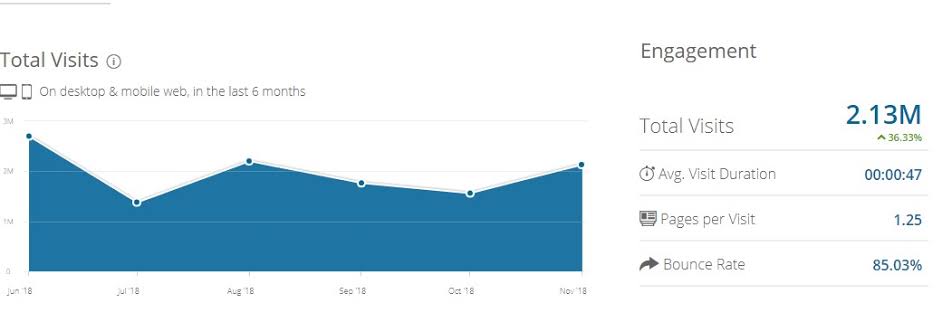
For example, when the concept of SEO was first introduced, many SEO posts were highly robotic and technical. Here is an example of this:

Of course, these did help the site rank for key keywords, but none of these posts were for “real” people, the ones reading this content.
That’s why we started to produce content that is completely user-oriented and written for reading! Like the example below:
He used expressions that most clearly explained the main issue to the users:

It also brought the content to a level that non-developers in the web world can understand.
Facebook Ad Suggestion # 7 Plan a long-term strategy
Facebook ads are usually compared with Google ads. This is because they are basically following a similar proposal model.
However, if you go deeper, you will see that there is a big difference between both. People who search on Google often seek things to read, read.
However, Facebook users who saw your ads are not looking for anything, just browsing news flows.
This means that you are really to be successful in Facebook ads, instant returns should not think of. But your long-term strategy should still be.
Thus, the contents became much easier to read and humane for users from all groups.
In other words, the content was written for both Google and readers.
So how will you do this? Now we come to the SEO part with the basic steps!
2. How to Produce SEO Compatible Content that “Burns” User Experience?
The word “user experience” is one of the jargons circulating in almost everyone in the SEO world.
In fact, what this concept refers to is extremely simple.
When measuring content quality, Google looks at bounce rates, stay rates, and Pogo Sticking rates.
These are the details that directly show the quality of the user experience.
Pogo Sticking; When the user makes a search, he or she cannot find the comprehensive content he is looking for on the sites he enters, so it is a case of visiting many sites.
These ratios basically inform Google about the content strategy.
SEO experts agree on this.
Content that signals positive user experience will rank much better on Google. In fact, the reverse is also true.
Build the Structure of Your Content!
A lot of people think about SEO-friendly content as strings of consecutive words.
But in my experience and that of content creators, the structure of the content is just as important as the sentences used.
Two different things can happen when a user comes to your site through a search engine:
- They may not find the topic related to what they are looking for or they will leave the site immediately due to insufficient information.
- If they find the topic they are looking for and are interested, they stay on the site and continue reading.
If the user stays on your site, Google will think you are a strong site and will raise you in the rankings.
Well, if you say what happens when people leave your site just as they entered it, let’s tell you the answer right away; In this case, Google will lower your ranking considerably.

So the question is: How can users’ bounce rates be reduced?
The solution to this problem is to use sentences and phrases that encourage the reader to read.
Perhaps you have noticed that successful content usually includes sentences that appeal to the reader, such as.
These are the sentences that keep the user from leaving the full text and encourage him to read until the next brigade.
I’ve also used this strategy over and over to produce SEO-friendly content, and it really worked!
For example, on sites where this tactic is used, the stay rate can even go up to 03:03 minutes, which is a pretty good page stay time.
The point is, predicting the moment when the user will hit the “Back” button and placing this strategy at that point will increase the dwell time considerably.
Here are some ready-made examples of sentences:
- In short;
- So what is the real issue?
- You may be wondering:
- Here’s something crazy:
- Now comes the better / Now comes the worse:
- But the important thing is:
- Want to know the best part?
App Method
We understood that the Aquarius Brigade method contributed to the total time spent on the page. Another successful technique used to produce SEO compatible content is the App.
This technique is called the App method because of its English initials: Agree – Promise – Preview!
Presenting a commonality – Presenting a promise – And finishing the job with an overview of the content!
The first paragraph is particularly important in content. Because you will have explained what the content was written for in the first paragraph.
The connection you establish with the user in this section should show that you understand their problems.
This will indicate that users will prefer to read yours over other content!
You can see how to use this technique in more detail in the template below:
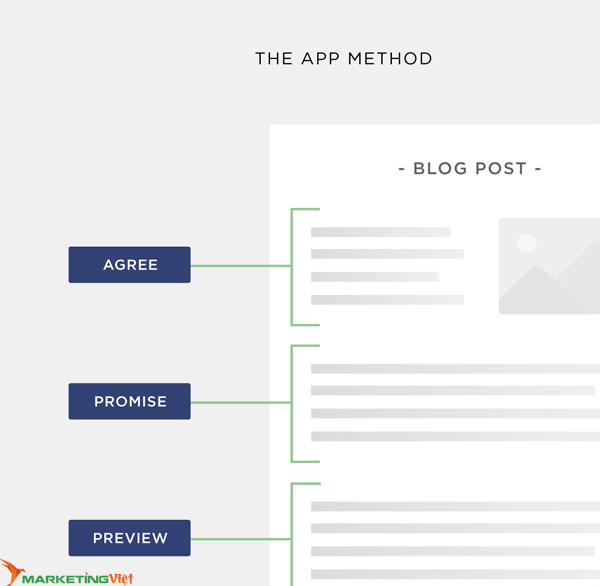
Therefore, the method that I have seen really works while saying what you are going to tell; I can say that I feel that I really understand the problem of the person in front of me.
After dealing with the issue of meeting at a common point, it is necessary to come to the part of presenting a promise.
In other words, to the Promise part as it is in the name of the method.
The promise is the part where you tell your readers that your content will “take them on a better adventure.” You can say this in many different ways.
Finally, let’s get to the step of getting an overview of the content.
In this section, we tell your readers, “Your time is valuable, I want it from you, but what I have to give is extremely valuable!” You have to give your message.
You should list any details in the content step by step.
If you make these lists clickable, the user will be able to go to any part of the content automatically, which will strengthen the user experience.
Let’s not go too far here is an example from this article:
3. Optimize For SEO Compatible Content Production!
If you want to produce SEO compatible content, you should add some keywords to the content. Well, this is no longer a secret after what I wrote from the beginning.
But now SEO has become much more than just using a few keywords on the relevant page.
For keywords with high competition, you need to use advanced strategies to rank high.
Since these are the most basic options, they are no longer sufficient in the SEO part. Luckily we’ll be taking a look at them today too! So let’s start!
Create and Use a Title Tag!

If you want more traffic from long-tail keywords, the solution is simple: use title tags!
“What are they?” I can hear you say.
These are some words that when you include them in your title make your title rise in long-tail keyword rankings.
The first thing you need to do is write a post on your page that has a short title tag.
Then add the following supplementary tags in the appropriate places:
- Fast
- Directory
- Easy
- Simple
- The best
- Examination
- Current
- Tips
You never know exactly which keyword will bring great results.
But rest assured that without them you won’t be able to generate strong enough traffic gains.
That’s why I recommend that you include these keywords in your articles.
Add LSI Keywords to Your Blog Contents!
Google is no longer the Google you know!
New Google systems powered by artificial intelligence don’t care how many times you use a keyword in your content.
What Google is really interested in is keywords called Latent Semantic Indexing (LSI).
This concept is also referred to as the LSI keyword in the Turkish SEO world. So what does it mean?
What these magic words mean to create SEO-friendly content is actually: “Use the related keywords and synonyms!”
These words will allow Google to better understand what exactly your blog content is about.
What you need to do to find LSI keywords is very simple.
Go to Google and do a simple search using the keyword you want to rank for.
When you scroll down to the bottom of the results page, you will see a list of ‘Related Searches’.
Don’t forget! This list is determined directly by Google.
So you won’t find a better list of LSI keywords than this! Plus it’s free…
Gaining Traffic for E-Commerce Products and Category Pages with SEO Compatible Content Production
Let’s be honest, while Amazon tops almost every e-commerce- related keyword, it’s not easy to rank for smaller startups.
However, I see that small e-commerce sites are participating in this race and are actually quite successful.
So what are their secrets?
Since they don’t have a budget like Amazon’s, they have to have a pretty strong strategy, right?
The strategy these e-commerce sites with a tighter budget follow is: Find and target long-tail keywords that their competitors don’t usually know or notice!
So how do they do this?
They go to the first e-commerce site and click on the search box.
Here, they write the product name.
Let the product name be “dog food”.
The images below show examples of the method.

Let’s move on: No clicking Enter after typing the name.
They discover long-tail keywords suggested by the search system because the system recommends them to them! E.g;
- dog mama goody
- dog food royal
- the dog is a small breed of mama
- the age of dog food
- enjoy dog food
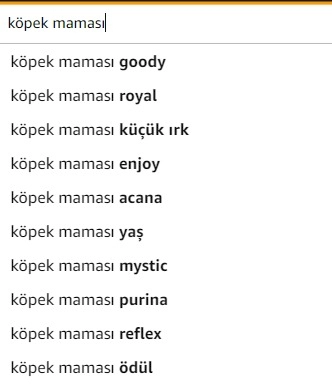
Then they search for one of the above on Google.
They check the difficulty rate of this keyword using various tools.
Among these keywords, they prefer options that are not very difficult and start working on them.
This study works as follows: It becomes possible to rise to the first ranks and increase page / website authority with less budget in words with low difficulty rate.
Finding a keyword with a low difficulty level by using the search buttons of shopping sites can help you stand out with a lower budget strategy.
When you add your chosen keywords to your strategy, you can create blog posts containing those words.
But basically, what you need to do is to use the words in question in the product names and descriptions!
4. Increase Your Organic Clickthrough Rates!

Are organic clickthrough rates an important factor for Google rankings?
Of course yes!
Even if it wasn’t, it would still be a great thing, as increasing organic clickthrough rates means getting more traffic and would contribute to increasing your rankings.
In this section, I will talk about how to turn your site into a “click magnet”. Let’s get started then!
Add Some Emotion to Your Headlines: Attention, Not Too Much!

According to industry studies, headlines that appeal to a certain emotion bring higher organic clicks.
Still, most of this data comes from studies on click-through rates on social media .
Therefore, these research results may not be accurate for the behavior of a Google user.
Could it not be?
Maybe not, but when we look at the truth of the matter, we see that the same results are exactly the same for Google.
In our current analysis, we evaluated 5 million Google search results, and according to the results, headlines with emotion generate much more organic clicks.
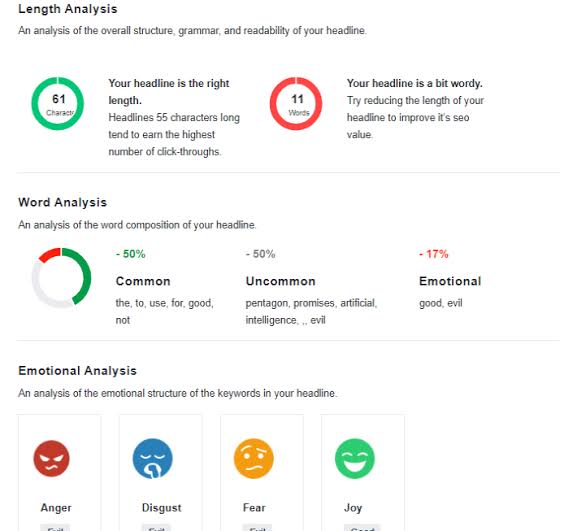
Okay, emotional titles are fine. So always?
No!
When the titles you create so that they contain emotion become “clickbait” titles, organic click-through rates begin to decline rapidly.

The main issue I want to talk about here is this; your tags and descriptions should contain a certain amount of emotional subtext. Positive or negative, it doesn’t matter. But no exaggeration!
Meta Description Markets Your Content!
Well-written meta descriptions always drive more clicks, according to Google’s data.
While producing SEO compatible content, meta description will make the main topic and marketing of your content.
While Google doesn’t always show your meta descriptions in search results, it’s still very important to have strong meta descriptions for each page.
Because when these appear in searches; markets your content, your service or even your entire brand to your audience!
Use Questions in Title Tags!
According to the same study, question-based tags generate 14 percent more organic clicks than other tags.
Of course, this does not mean that you should use questions in every tag.
But again, tags made of questions can be strategies worth trying.
5. Create Your Own Keywords!

In this section, I will talk about my favorite SEO-compatible content production strategy to date; creating your own keywords!
This strategy alone allows you to gain hundreds of backlinks and attract hundreds of visitors to your site.
Today I will talk about how this is done.
How Does Creating Your Own Keywords Contribute to SEO?
I don’t know if you’ve noticed before, but a brand name is actually a keyword.
A keyword that you managed to rank first.
So why exactly is our power cut off here?
Why can’t we go one step further?
As you integrate your techniques and strategies into your brand identity, you can generate extra organic traffic with the new keywords you create from them.
For example, you may have heard of the Skyscraper Formula , which you can use to drive more traffic to your site .
This technique, which has become quite popular, has become an identity of the brand by the creator of the technique.
This has enabled the Google Search Engine ” Skyscraper Technique ” searches to reach up to 2,030 monthly.
Yes, we are talking about a keyword that no one has ever searched before the branding process!

While using the skyscraper technique, Skyscraper searches Google and links to the sites that created this technique.
So Skycraper Technique is a very successful ‘ generated keyword ‘ example.
Many such keywords are generated by the site in question. These concepts, which were never used before, were created and became known.
Increasing page authority does not only generate organic clicks.
Introducing a new concept means that many sites on the internet refer to you when creating content related to a similar concept.
This allows you to earn organic backlinks.
For example, when a blogger mentions the “Skyscraper Method“, he often links to the site that created it.
Generate Strategy, Approach or Concept!
So the first thing you should do is; produce a strategy, approach or concept unique to you and give it a name.
The Skyscraper Technique is a good example of this.
To create something like this, you can take an already working method and add a step to make it more effective.
For example, many methods that are frequently used in the marketing world have emerged from concepts that someone has produced:
- blogs
- Inbound Marketing (e.g. hUBSpot created it)
- Influencer Marketing
- Chat Bots
- Conversion Rate Optimization
- Digital marketing
In many cases, these generated concepts stay alive over the years.
But they do not remain what you originally produced: they are constantly transforming.
In other words, when you name something, you make it real.
But how to give something an interesting, catchy name, there is no clear formula.
Naming it one way or another, it will work.
Publish the Keyword You Generated!
It’s not just about naming a strategy and using it somewhere.
If it were, many people who create their own strategies every day would rank highly on Google.
If you want to turn your idea into a keyword people search for and create a hit source for your website, you must first introduce it to people in the most comprehensive way.
For example, after the Skyscraper Technique that I mentioned was developed, this word was used and spread by developers in many places.
Field studies on how this method will work have been prepared, and step-by-step guide content has been published.
The Skyscraper Technique was also mentioned in the visitor posts.
And there are even detailed videos on Youtube about how this strategy works.
Also, some content about the rise stories was shared as other people and projects use the “Skyscraper Technique” to get traffic. All these were included as stages of keyword generation.
6. Advanced SEO Compatible Content Creation Strategies
Let’s take a closer look at my favorite SEO content creation tips, strategies, and techniques.
What will you learn about SEO-friendly content production in this section? Let me say:
- How to create interesting URLs?
- What are the easy ways to gain social media engagement in content?
- How to find a large number of long-tail keywords that have not been used before?
- How to get ”Zero Rank” on Google?
- and much more!
- Use Short URLs With The Keywords You Want To Rank For
Do short domain names (URL) help you rank higher on Google?
According to a previous study of search engine ranking factors , there is a strong correlation between short domain names and high Google rankings.
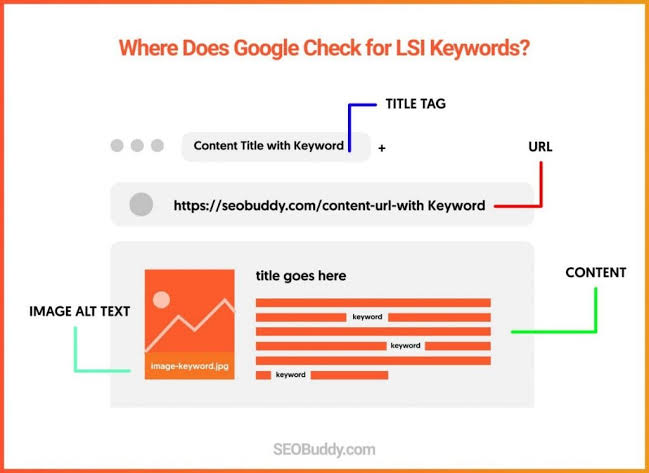
Domain names with keywords also get more clicks.
The main issue here is: you need to produce domain names that are short and rich in keywords.
For example, a URL created for SEO tools only; I’m talking about “/seo-tools”.
Or just the domain name of the content in a guide about email marketing; It’s like having “/email-marketing-guide”.
Note: Are the domains you have used so far on your site long?
So I don’t recommend going back and rebuilding them.
In this case, you may experience a lot of problems in terms of technical SEO.
For now, try to apply this rule to the pages you create in the future.
- Find Undiscovered Topic Ideas on BuzzSumo’s ”Discover Topics” Page!
BuzzSumo has a little-known feature, and I think it’s pretty powerful.
To use it, type a keyword you normally know into the system.
You will come across words and phrases with different volumes related to this word.
The best feature of this tool is: It does not offer variations of the keyword you specified, it offers you creative areas with similar topics with the keywords you specify.
That means you have a much wider set of alternatives!
- Try Clicking Tweet Buttons!
Activate social sharing buttons to get more shares.
But let me be honest about this, they won’t do miracles for you.
If you want high sharing rates in every content you publish, you need to add “click tweet” buttons.
In this way, the number of shares will increase noticeably.
What’s more, thanks to this ‘Click on the tweet’ button, your profile will also get a lot of followers.
So how can you do something similar?
First, create a strategy for your own content that will drive users to action and decide where to add the tweet button.
- Add “Snippet Bait” Sections to Your Content
Snippet Bait sections are areas that will make your content rank as a ” Featured Snippet “.
You can place Snippet Baits anywhere on your page. But I usually use the top of the page and recommend it.
You ask why?
I think Google likes the pages with these sections on top 🙂

What’s more, such areas help your site visitor quickly find the answer they’re looking for.
Either way, wherever you position the Snippet Bait, these parts significantly increase your chances of landing in the so-called “zero rank” area of Google.
Result: SEO Compatible Content Production!
We have come to the end of the content of the SEO compatible content production guide that I have prepared for you.
Honestly, I’d like to hear some strategy advice or experience stories from you, too.
Which of the SEO-compatible content production strategies I have given you will you try first?
The “Click Tweet” button? Or the idea of generating your own keywords?
Whatever experience you have about SEO copywriting, I would love for you to share it with me!
See you in the next content!
You can become a member of our site to grow your Instagram accounts and increase your followers, likes, views and subscribers. Click to see our social media products

